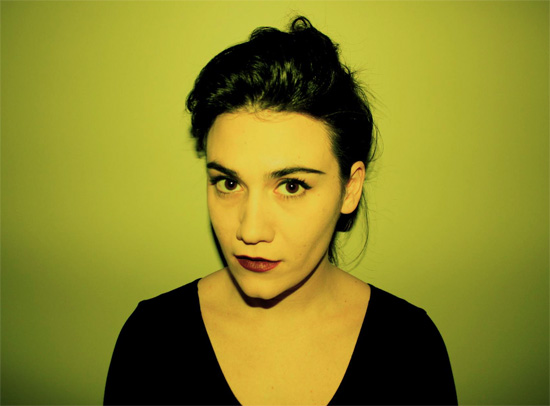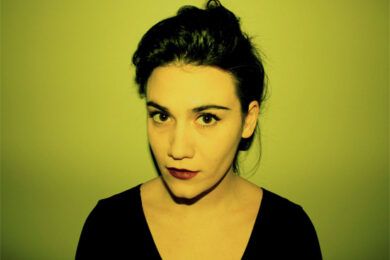On the face of it, St Bartholomew’s is not the prettiest church in Brighton. The imposing, box-like structure looks like it was designed by a six-year-old let loose with crayons. Tonight, however, St Bart’s is the setting for a Nadine Shah gig, and the Northumbrian singer-songwriter has instantly made the cavernous interior feel like an intimate confessional. Her mournful voice fills the space and silences her rapt audience. Dressed in black – she describes a new leather jacket as a "mid-life crisis purchase" – Shah’s elegant ballads pulse with beautiful sorrow.
But, thankfully, that’s not to say that Shah is laden with all-consuming doom. The day before the show I’d met up with her in an old-school pub on the edge of Brighton’s North Laine area and she is fantastic company – a blur of comedy accents, rip-roaring anecdotes and a healthy dollop of self-deprecation.
She’s also refreshingly direct. I ask her about the single ‘Dreary Town’ – the first song she ever wrote. She tells me it is about "my boyfriend at that time – it was about our time together in London when we were skint." That boyfriend would later commit suicide. "It was horrible – ‘Dreary Town’ was written two days after I heard he’d passed away and wasn’t meant to be therapeutic. It was written as an ode to someone who I loved and someone who was brilliant."
It’s only a few minutes into our interview. Shah speaks gently about her friend. "He was a very talented fashion designer. It transpired that he was bipolar, and at the time I didn’t know that when we dated. I only found out at the funeral that he was bipolar and everything made sense. During our relationship he was great one moment and wouldn’t look at me the next. If I had known more about his illness and if he had been diagnosed sooner then maybe he would still be alive. It’s one of the reasons I want to write about these things and talk about them."
Mental health is a hugely important issue for Shah. Her debut album, the compelling, Ben Hillier-produced Love Your Dum And Mad, was largely inspired by the tragic deaths of two young men. "There are two boys that this album is predominantly about," she continues. "During the period of time these songs were written two very close friends took their own lives. The first one was Stuart and the second one was Matthew. I was in love with both of these boys. Matthew was an amazing painter and the album’s title is taken from one of his paintings. He went to art school with my brother and was very talented and a real extrovert. If you’d met him, you’d never forget him. He had a heroin addiction and had been in a coma and was never the same again. He killed himself a few months later.
"The worse thing for Matthew was having to live in the shadow of stories of his former self," she says. "But after he’d come out of the coma his paintings were fascinating. One of them was called ‘Love Your Dum And Mad’. Matthew was always going to design the cover of my first album, and it was really fucking important for me to have his work on the cover.
"I’m not trying to get a sympathy vote from people – lots of people’s friends die – but I don’t want mental health problems, especially in young men, to be a taboo subject. Mental health is almost like a plague that no one will talk about. Maybe I could have still had my best friends with me. If you have a friend who has cancer, everyone is there for them. People can empathise. But mental illness is essentially abstract, as you cannot see it. It’s not an open wound that can be healed. I want to talk about it and not be a subject that people feel uncomfortable talking about."
We reflect on the staggering statistic that suicide is the single biggest killer of young men between the age of 15 and 35. Behind that infectious sense of fun lies a deep well of regret and sorrow. It’s an easy leap to understand the dark grandeur of Love Your Dum And Mad.
The singer herself has been diagnosed with chronic anxiety, after suffering a series of panic attacks when she was younger. "Once it had a label, it’s made me feel a lot better," she reflects. "I now know that when I get these panic attacks, I’m not having a heart attack. I’m more aware of what triggers them and maybe why they happen. When they do happen, they are much more manageable."
After opening with several minutes of deeply moving conversation, I sense the need to backtrack a little and lighten my line of questioning. Shah grew up in the Northumbrian seaside village of Whitburn. The family cliff-top house was "20 paces to the edge" and she’d spend her childhood playing amongst the sand dunes. Her mum is Norwegian ("which means I like raw herring") and her dad is Pakistani. "My father has a beautiful singing voice," Shah reveals. "He only sings in his own language and he sings these wonderful songs called ghazals."
Ghazals are usually taken from ancient Arabic poetry and are typically seismically desolate songs about illicit and unattainable love. For a long time Shah could not see any connection between her music and her father’s heartbreaking ghazals. "Then, I played a kind of ‘Pakistani-friendly’ night a while back with an author called Mohsin Hamid, who has written books like The Reluctant Fundamentalist," she recalls. "There were a lot of Pakistani people in the audience and many people came up to me and said my songs did remind them of ghazals, in the way that I sing and the subject matter being very similar to those sad love songs. I’d never made that connection before."
Shah’s songs are more commonly compared to PJ Harvey ("I get that – we both sound serious and both have big noses") and Nick Cave ("I love him but I don’t want to be a ‘female Nick Cave’"), however she cites her main influences as being outside the sphere of music. The artists William Hogarth and Frida Kahlo are mentioned and, as a non-musician, I’m intrigued to know how an 18th century painter could have influenced Love Your Dum And Mad. "I used to study art," she reveals. "I loved how Hogarth could depict scenes of pure debauchery. There would be paintings of lords and dukes in amazing outfits, with prostitutes sat on their laps. I’m pretty sure he gives me a good insight into that time. That’s what I like about his work. As soon as you see his images, you are invited into that world. I wanted to use an aspect of that in my songs."
And the world Shah conjures up is very real, crammed with tales of maudlin old blokes in pubs (‘To Be A Young Man’) and marriages shattered by adultery (‘Runaway’). "I’m always interested in simple things that you can relate to," she explains. "I will never write lyrics laced in metaphor as it is not how I speak and it is not how I think. Maybe that’s why I like the poetry of Phillip Larkin and it is why I like Frida Kahlo. Frida Kahlo had a brutal honesty about her – almost too brutal of an honesty."
As a 17-year-old, Shah headed to London ("I was very lucky as my parents paid for a flat for me and my brother") and began singing in the Pizza Express Jazz Club in Soho. "I felt like a burden on my brother," Nadine recalls, by way of explanation for her choice of pastime. "I used to pretend to him that I was going out with friends, and I would just go to the jazz club and hang out with the old dudes who were playing. I sat at the bar every night and they would give me drinks and pizza. But, I also met some legends like Mose Allison – I sang a session with him."
I get another hit of Shah’s expertise when I see her play a second show the day after the St Bart’s gig – this time in a tiny, sweaty club on Brighton’s seafront. Again, her beguiling voice cuts through the stuffy atmosphere and overbearing chatter. Shah’s singing style is pure and true, and bereft of any of the vocal acrobatics that sully so much modern pop music.
"I got into jazz when I stumbled across Nina Simone’s music," she reveals, when I ask about the impact her time at the jazz club might have had on Love Your Dum And Mad. "Hers was the first voice that I had heard that really struck a chord with me. I loved the androgynous voice – it was so honest and kind of ugly at times, but it had a beauty about it. However, I had grown up listening to Mariah Carey and Whitney Houston, so I had learned really bad vocal habits. I’d put in extra notes all the time and every song was an opportunity to show off, instead of being an opportunity to portray an emotion or a story. When I met up with the guys at the jazz club later on, they got rid of all that. They told me to sing songs straight, in my own accent. So, I had these brilliant mentors – I am their protégé. They taught me technique and discipline."
Much of Love Your Dum And Mad reflects just how much Nadine Shah took from her time singing jazz music. There is a laser-guided honesty to her work that requires no gimmickery or buzz sheen. "Most of the album is four years old," she remarks, as we wrap up our chat. "What is frustrating about the album is that it’s the first thing to come out and I’m being valued and critiqued on it. I’m 27 and I think I should be writing better lyrics than those on the album. I’m almost a little bit embarrassed by some of it, but, in a way, I’m also really proud of the kid that wrote them." And so she should be.
After the tape recorder is switched off, I try to impress Shah with my command of Urdu but the only phrase I know – apart from a collection of diabolical swear words – translates as asking for her hand in marriage. She politely declines my proposal but does offer to send me an item of tour merchandise. It’s a plain white t-shirt with the words ‘Go Nads’ emblazoned across the front. I promise to wear it.
Nadine Shah’s Love Your Dum And Mad is out now via Apollo



